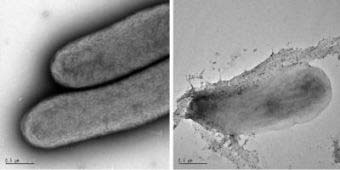Discover new biofuels
A new bacterium made for cellulose can be used to make ethanol and other biofuels. Scientists at the University of Texas at Austin say that the bacterium can provide a significant amount of transport fuel for the nation if this mode of production is promoted.
In addition to cellulose, cyanobacteria is caused by Professor R. Malcolm Brown Jr. and Dr. David Nobles Jr. also produces glucose and sucrose. These two simple sugars are the main source of ethanol production.
Nobles, a research member of the Molecular Genetics and Microbiology Agency, said: "The cyanobacteria is a potentially very cheap source of sugar to produce ethanol and other fuels."
According to Brown and Nobles, their cyanobacteria can grow under production conditions on non-cultivated land using saltwater that is unsuitable for humans and crops.
Other important findings include:
- The new strain of cyanobacteria uses sunlight as an energy source to produce and excrete sugar and cellulose.
- Glucose, cellulose and sucrose can be harvested continuously without harming or killing cyanobacteria (harvesting cellulose and sugar from algae or crops such as corn or sugarcane must kill bacteria and must use enzymes and mechanical methods for sugar extraction.
- The cyanobacteria can fix atmospheric nitrogen molecules that can grow without oil-based fertilizers.
Research by two recently published scientists in Cellulose.

Left: Two wild rod-shaped cyanobacteria cells that do not contain cellulose or sugar on the surface.
Right: A cyanobacteria that has been genetically engineered for cellulose production (cellulase combined with a dense yellow indicator electron).
Photo: Brown and Nobles, University of Texas at Austin
Nobles created a new strain of cyanobacteria (also known as blue-green algae) by transplanting a group of genes that produce cellulose from a non-photosynthetic vinegar called Acetobacter xylinum known as micro alias. bacteria producing cellulose yield.
The new cyanobacteria produces gel-like cellulose which is quite clear and can be easily broken down into glucose molecules.
According to Nobles, 'the problem with cellulose in plants is that the molecule is difficult to break down due to the high crystal structure that mixes the lignin and other compounds' .
He was surprised to find that cyanobacteria also release large amounts of glucose or sucrose, sugar molecules that can be harvested directly from bacteria.
Nobles said: 'Producing ethanol and biofuel from cellulose using enzymes and mechanical methods to break down cellulose requires a huge cost. While using cyanobacteria will solve this economic problem. '
Sources being used or being studied for ethanol production in the United States include grass and wood (cellulose), corn (glucose) and sugarcane (sucrose). Algae is also being studied to produce biodiesel.
Brown found that the use of cyanobacteria in production had a major benefit: reducing the amount of converted land to produce fuel, while reducing the pressure on the forests.
Brown - Johnson & Johnson Centennial Chair of Plant Cell Biology - said: 'Pressure will weigh on all corn growers to produce corn but not for food purposes. The same requirement for sucrose is taking place in Brazil as more Amazon rainforests are replaced by sugarcane fields due to increasing energy demand. We don't want that because we will never get those forests back. '
Brown and Nobles estimate that the approximate area needed to produce corn ethanol is to provide fuel for all US transportation needs at about 820,000 square miles - equivalent to the size of the entire metropolitan area. North United States.
They hypothesized that they could produce the same amount of ethanol using an area that is only half the size of the cyanobacteria with the current level of efficiency achieved in the laboratory. But they also said that there is a lot of work needed to make cyanobacteria able to produce real fuel. Using photovoltaic bioreactors, we can know that the productivity of bacteria in the laboratory is likely to increase 17 times . If this number can be achieved in practice on a large scale, only 3.5% of the above corn acreage can be used to produce cyanobacterial biofuels.
Brown said cyanobacteria are just one of many potential solutions for self-healing fuel sources.
Brown said: 'There are many ways to help us create our own energy, and we want to contribute in that joint effort. Oil is a precious commodity. We should use it to create useful products, not just to burn it and turn it into CO2 gas'.
Brown and Nobles are currently studying the most effective methods to increase the productivity and production efficiency of cyanobacteria. Two applications were granted exclusively 20080085520 and 20080085536 recently published in the United States Patent and Trade Office.
- Discover potential biofuels
- Leading candidate of biofuels
- Make the first flight with biofuels
- Biofuels: The problem lies in policy
- EP supports the conversion of biofuel use
- Successfully producing the cheapest biofuels in the world
- China: Production of oil-eaten aircraft
- Mexico successfully researched biofuels from spirulina
- Test biofuel from desert plants
- India adopts biofuels policy
- Biofuels can increase pollution 4 times
- Biofuels cause controversy over the food crisis
 Why do potatoes have eyes?
Why do potatoes have eyes? 'Tragedy' the world's largest carnivorous life: Death becomes ... public toilet
'Tragedy' the world's largest carnivorous life: Death becomes ... public toilet Tomatoes were once considered 'poisonous' for 200 years
Tomatoes were once considered 'poisonous' for 200 years Detecting microscopic parasites on human face
Detecting microscopic parasites on human face